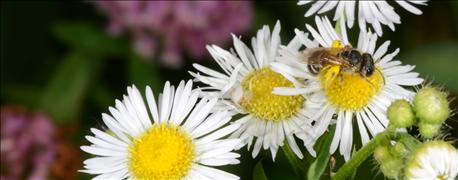
Gov. Mark Dayton of Minnesota created quite the buzz when he issued an executive order related to neonicotinoid insecticides in late August. It wasn’t long before the rumor mill spread it across social media. More than once the message was that Minnesota just banned neonicotinoid insecticides. As it turns out, there was no ban. However, he sent a strong message to Minnesota agencies and farmers, and apparently to those hundreds and thousands of miles beyond Minnesota’s borders.
See related story: Ag committee hears concerns about governors pollinator executive order
Here’s what did and did not happen.

RUSH TO CONFUSION: When is news from another state vital to you in Indiana? It’s vital when it’s been misinterpreted. The subject is protection of pollinators, such as this solitary bee. (Photo: John L. Obermeyer, Purdue University)
Did happen: Dayton issued an executive order charging the Minnesota Department of Agriculture with taking “immediate action to implement” new departmental recommendations pertaining to use of neonicotinoid pesticides in the state. Neonics are most commonly used as seed treatments for both corn and soybeans, and have taken fire in recent years because of concerns over honeybee health.
Did not happen: Dayton did not issue an immediate ban on the use of neonics in Minnesota. Sources say there is a large difference between an executive order calling upon an agency to take action and imposing an immediate, outright ban.
Did happen: The Minnesota Department of Agriculture issued a report called “Review of Neonicotinoid Use, Registration and Insect Pollinator Impacts in Minnesota.”
Did not happen: The report was not a random act by MDA. It resulted from a 2013 Minnesota legislative decision for MDA to review neonic use in the state.
Did happen: The 120-page final report included proposed action steps regarding the use of neonics in Minnesota.
Did not happen: The recommendations did not include an outright ban on neonic use by farmers.
Did happen: A few of the proposed actions in the MDA report included “verification of need” prior to the use of neonics, increasing inspections and enforcements of pesticide label requirements that are toxic to honeybees, and increased education. The education component included development of best management practices and education for users on how to minimize exposure to neonics for pollinators.
Did happen: The Minnesota House Agriculture Policy Committee hosted an information hearing. Testimony from farmers indicated they were blindsided by the governor’s executive order and by MDA��’s review of neonics.
Did not happen: According to testimony at the hearing, farmers and the ag industry in Minnesota were not properly consulted in preparation of the report.
Did happen: State Rep. Paul Anderson, R-Starbuck, said, “The Department of Agriculture testified it is not looking to ban neonics, rather to reduce the use, and [MDA] also indicated farmers are not abusing neonics. What is the point of the order if farmers are already adhering to labels and doing the right things as stewards of the environment?
Did not happen: All questions were not answered at the hearing. One commodity leader commented that people left with more questions than answers.
Did happen: The order created a new committee on pollinator protection to advise the governor, Environmental Quality Board, Interagency Pollinator Protection team and other participating agencies.
Did not happen: To date, nothing similar to this has happened in other states, including Indiana. Purdue University entomologist John Obermeyer notes that he is not aware of any such action in the works in Indiana.
Paula Mohr, editor of sister publication The Farmer, contributed to this article.
About the Author(s)
You May Also Like




